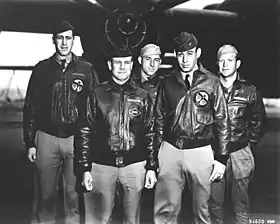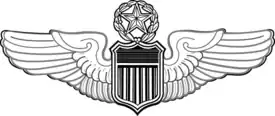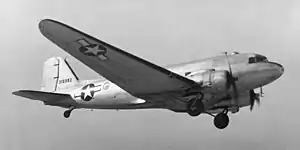Richard E. Cole | |
|---|---|
.jpg.webp) Cole in 2014 | |
| Birth name | Richard Eugene Cole |
| Nickname(s) | "Dick" |
| Born | September 7, 1915 Dayton, Ohio, U.S. |
| Died | April 9, 2019 (aged 103) San Antonio, Texas, U.S. |
| Buried | |
| Allegiance | |
| Branch | |
| Years of service | 1940–1966 |
| Rank | |
| Unit | 17th Bomb Group 1st Air Commando Group |
| Commands held | 831st Combat Support Group |
| Battles/wars | World War II Korean War |
| Awards | Distinguished Flying Cross (3) Bronze Star Medal Air Medal (2) |
Richard Eugene Cole (September 7, 1915 – April 9, 2019) was a United States Air Force colonel. During World War II, he was one of the airmen who took part in the Doolittle Raid on Tokyo, Japan, on April 18, 1942. He served as the co-pilot to Lieutenant Colonel Jimmy Doolittle in the lead airplane of the raid by sixteen B-25 bombers, which for the first time took off from an aircraft carrier on a bombing mission.
Cole remained in China after the raid until June 1943, and served again in the China Burma India Theater from October 1943 until June 1944. He later served as operations advisor to the Venezuelan Air Force from 1959 to 1962. He retired from the Air Force in 1966 and became the last living Doolittle Raider in 2016[1]
Early life
Richard "Dick" Cole was born on September 7, 1915, in Dayton, Ohio.[2] He graduated from Marion L. Steele High School and went on to attend Ohio University for two years.[3]
Military career
Doolittle Raid

Cole enlisted as an aviation cadet in the United States Army Air Forces on November 22, 1940, at Lubbock, Texas.
He was commissioned as a second lieutenant in July 1941 and rated as a pilot, when he was awarded his pilot wings at Randolph Field, Texas, on July 12, 1941. His first assignment was as a B-25 Mitchell pilot with the 34th Bomb Squadron of the 17th Bomb Group at Pendleton, Oregon, in July 1941.[4]
Cole was assigned as the co-pilot of the first B-25 Mitchell medium bomber (Aircraft Number One), plane # 40–2344, for the famous "Doolittle Raid" in the wake of the attack on Pearl Harbor after two other pilots became ill.[5] The raid was daring not only because of the intended targets, the Japanese homeland and its capital Tokyo, but because the pilots trained to take-off in a B-25 bomber from the deck of an aircraft carrier, something neither the designers of the B-25, nor the aircraft carrier, ever envisioned. Cole was co-pilot in the first bomber to depart the deck of the USS Hornet during the mission, and it was piloted by the leader of the raid, then-Lieutenant Colonel Jimmy Doolittle,[6] giving him, and the plane, the very least amount of runway available.
On April 18, 1942, Doolittle and his B-25's four crewmembers, took off from the Hornet, reached Tokyo, Japan, bombed their target,[7] then headed for their recovery airfield in China. Doolittle and his crew bailed out safely over China when their B-25 ran out of fuel after flying 2,500 miles (4,000 km). By then, they had been flying for about 13 hours,[8] it was nighttime, the weather was stormy,[3] and Doolittle was unable to locate their landing field in Quzhou. He and his crew linked up after the bailout and were helped through Japanese lines by Chinese guerrillas and American missionary John Birch.[9]
Post raid
After the raid, Cole remained in China and flew C-47 Skytrains to transport supplies from Burma to China over the dangerous Himalayan mountains known as The Hump, from May 1942 to June 1943. He later served with the 5th Fighter Group in Tulsa, Oklahoma, from June to October 1943.
Cole then volunteered for Project 9, which was the birth of the Air Commandos. He served as an original Air Commando in the Transport Section of Project 9 in the CBI Theater. They took part in the Invasion of Burma, where they invaded with gliders, built a couple of airfields behind Japanese lines, which was the beginning of the march from northeastern India by the ground forces to retake Burma. Cole served with the Air Commandos from October 1943 until he returned to the United States in June 1944.[10]
His next assignment was as an Army Air Forces plant representative and acceptance test pilot at Wichita, Kansas, from June 1944 to October 1945, and then as officer in charge of the training section at Victorville Army Air Field, California, from October 1945 to November 1946. Cole went on terminal leave beginning November 13, 1946, and left active duty on January 11, 1947.[4]
Post war
Cole returned to active duty on July 7, 1947, and served on the group staff at Wright-Patterson Air Force Base, Ohio, from July 1947 to January 1952, followed by attending the Armed Forces Staff College at Norfolk, Virginia, from January to September 1952.
During the Korean War, Cole next served on the staff of Far Eastern Air Forces in Japan from September 1952 to March 1955, and then on the staff of Headquarters U.S. Air Force in the Pentagon from March 1955 to July 1958.[4]
After attending Spanish language training, he served as an advisor to the Venezuelan Air Force in Caracas, Venezuela, from January 1959 to August 1962, followed by service with the 464th Troop Carrier Wing at Pope Air Force Base, North Carolina, from August to October 1962. His next assignment was on the staff of the Joint Development Group at Fort Bragg, North Carolina, from October 1962 to February 1963, and then as director of operations, executive officer, and as vice commander of the 831st Combat Support Group at George Air Force Base, California, in February 1963.[4]
Cole retired from the military in 1966.
Post-retirement

On May 23, 2014, Cole was present in the White House when President of the United States Barack Obama signed a bill on awarding the Congressional Gold Medal to the Doolittle Raiders. On April 15, 2015, President Obama presented the Congressional Gold Medal to Cole and three other surviving members of the raid, in a ceremony at the White House.[11][12]
Cole was the last surviving participant in the Doolittle Raid. Staff Sergeant David J. Thatcher, gunner of aircraft No. 7, died on June 23, 2016, at the age of 94.[4][13][14] Cole, who lived to be 103, was the only participant to live to a higher age than the raid's leader, Jimmy Doolittle, who died in 1993 at age 96.[15]
On September 19, 2016, the Northrop Grumman B-21 was formally named "Raider" in honor of the Doolittle Raiders.[16] As the last surviving Raider, Cole was present at the naming ceremony during the Air Force Association conference.[17]
Death and burial
Cole died in San Antonio, Texas, on April 9, 2019, at the age of 103.[18][19][3][20] A memorial service for Cole was held at Joint Base San Antonio on April 18, the 77th anniversary of the Doolittle Raid.[21][22]
Cole was scheduled to be buried with full military honors at Arlington National Cemetery.[23] Originally planned for August 2019, his burial was postponed to April 18, 2020, the 78th anniversary of the Doolittle Raid, but that was delayed by the COVID-19 pandemic. His family finally decided to have Cole buried along with his wife at Fort Sam Houston National Cemetery in San Antonio on September 7, 2021, his 106th birthday.[24]
Cole was posthumously promoted to Colonel at the ceremony at Joint Base San Antonio on September 7.[25]
Family
Cole was married to Lucia Martha "Marty" (Harrell) Cole, who died in 2003 at the age of 79, for 59 years. They had five children and numerous grandchildren.[3][26]
Military awards
Cole received the following decorations and awards:[27]
 | ||
References
- ↑ Goldstein, Richard (June 22, 2016). "David Thatcher, Part of '42 Doolittle Raid on Japan, Dies at 94". The New York Times.
He was 94 and the next-to-last survivor among the mission's 80 airmen. His death... leaves Richard Cole, age 100, as the last surviving veteran of a legendary chapter in Air Force history. Mr. Cole was a co-pilot alongside Lt. Col. James H. Doolittle, the raid's commander and pilot of its lead plane.
- ↑ Piper, Gary (May 2012). "Surviving Doolittle Raiders Attending The Reunion" (PDF). EAA Chapter 863. Experimental Aircraft Association. Archived from the original (PDF) on December 15, 2019. Retrieved April 10, 2019.
- 1 2 3 4 Goldstein, Richard (April 9, 2019). "Richard Cole, 103, Last Survivor of Doolittle Raid on Japan, Dies". The New York Times. Retrieved April 9, 2019.
- 1 2 3 4 5 "Richard E. Cole, 0-421602, Colonel, Co-Pilot Crew 1". www.doolittleraider.com.
- ↑ Losey, Stephen (April 10, 2019). "A legend passes: Dick Cole, last of the Doolittle Raiders, dies at 103". Air Force Times.
- ↑ "80 Brave Men: The Doolittle Tokyo Raiders Roster". www.doolittleraider.com.
- ↑ Okerstrom, Dennis R. (December 31, 2015). Dick Cole's War: Doolittle Raider, Hump Pilot, Air Commando. University of Missouri Press. pp. 153. ISBN 9780826273550.
- ↑ Barber, Barrie (April 14, 2017). "WWII 75 years later: 101-year-old Dayton man relives Doolittle Raid". Dayton Daily News. Retrieved April 10, 2019.
- ↑ Oliver, Charlotte C. (May 27, 2017). "Doolittle raid gave America a boost". Nevada Appeal. Archived from the original on November 27, 2020. Retrieved April 10, 2019.
- ↑ King, Lauren (April 9, 2019). "The last surviving Doolittle Raider, Richard E. Cole, dies at 103". ABC News. Retrieved April 25, 2019.
- ↑ Miller, Jake (May 23, 2014). "Obama signs bill awarding Congressional Gold Medal to Doolittle Raiders". CBS News. Retrieved September 30, 2022.
- ↑ "Last of the Doolittle Raiders from World War II". The Sydney Morning Herald. May 15, 2019. Retrieved September 30, 2022.
- ↑ Howell, Kellan (September 5, 2015). "Richard Cole, last of two surviving 'Doolittle Raiders,' turns 100 on Labor Day". The Washington Times.
- ↑ Horton, Alex (June 23, 2016). "1 member of the Doolittle Raid remains as fellow airman dies". Stars & Stripes. Archived from the original on October 28, 2018. Retrieved August 25, 2016.
- ↑ Frank Kappeler and Thomas Griffin also lived to age 96, but not as many months as Doolittle.
- ↑ Martin, Mike (September 19, 2016). "The B-21 has a name: Raider". Air Force Public Affairs Agency.
- ↑ Giangreco, Leigh (September 20, 2016). "Last surviving Doolittle Raider rises to name Northrop B-21". FlightGlobal.
- ↑ "Last surviving Doolittle Raider passes away". Troy Daily News. Troy, Ohio: AIM Media Midwest. April 9, 2019. Archived from the original on April 9, 2019. Retrieved April 9, 2019.
- ↑ Losey, Stephen (April 9, 2019). "A legend passes: Dick Cole, last of the Doolittle Raiders, dies at 103". Air Force Times. Sightline Media Group. Retrieved April 9, 2019.
- ↑ Stephens, Andrew (April 9, 2019). "Lt Col Dick Cole, last surviving Doolittle Raider, passes away at age 103". Af.mil. Air Force Public Affairs Agency. Retrieved April 10, 2019.
- ↑ Losey, Stephen (April 12, 2019). "Memorial for Dick Cole, last of Doolittle Raiders, to be held on 77th anniversary of his legendary mission". Air Force Times. Sightline Media Group.
- ↑ Gast, Phil; Roth, Richard; Patterson, Thom (April 9, 2019). "Dick Cole, last of the Doolittle Raiders, dies at 103". CNN. Retrieved April 11, 2019.
- ↑ Filby, Max (August 18, 2019). "Demand for veteran burials could put strain on national cemeteries". Dayton Daily News. Retrieved November 3, 2020.
- ↑ Christenson, Sig (September 7, 2021). "Dick Cole, co-pilot of Jimmy Doolittle in famed Tokyo raid, buried at San Antonio's Fort Sam". San Antonio Express-News. Retrieved November 3, 2020.
- ↑ Thayer, Rose L. (September 8, 2021). "Air Force Posthumously Promotes Dick Cole, Last of the World War II Doolittle Raiders". Military.com. Retrieved November 3, 2020.
- ↑ "Lucia Cole - Obituary". San Antonio Express-News. January 19, 2003 – via legacy.com.
- ↑ "Valor awards for Richard E. Cole". Military Times. Sightline Media Group. Retrieved April 23, 2019.
